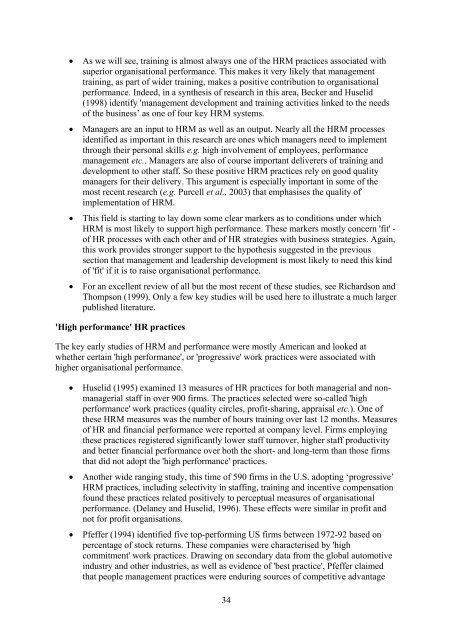The Development of Management and Leadership Capability and its ...
The Development of Management and Leadership Capability and its ...
The Development of Management and Leadership Capability and its ...
You also want an ePaper? Increase the reach of your titles
YUMPU automatically turns print PDFs into web optimized ePapers that Google loves.
• As we will see, training is almost always one <strong>of</strong> the HRM practices associated with<br />
superior organisational performance. This makes it very likely that management<br />
training, as part <strong>of</strong> wider training, makes a positive contribution to organisational<br />
performance. Indeed, in a synthesis <strong>of</strong> research in this area, Becker <strong>and</strong> Huselid<br />
(1998) identify 'management development <strong>and</strong> training activities linked to the needs<br />
<strong>of</strong> the business’ as one <strong>of</strong> four key HRM systems.<br />
• Managers are an input to HRM as well as an output. Nearly all the HRM processes<br />
identified as important in this research are ones which managers need to implement<br />
through their personal skills e.g. high involvement <strong>of</strong> employees, performance<br />
management etc.. Managers are also <strong>of</strong> course important deliverers <strong>of</strong> training <strong>and</strong><br />
development to other staff. So these positive HRM practices rely on good quality<br />
managers for their delivery. This argument is especially important in some <strong>of</strong> the<br />
most recent research (e.g. Purcell et al., 2003) that emphasises the quality <strong>of</strong><br />
implementation <strong>of</strong> HRM.<br />
• This field is starting to lay down some clear markers as to conditions under which<br />
HRM is most likely to support high performance. <strong>The</strong>se markers mostly concern 'fit' -<br />
<strong>of</strong> HR processes with each other <strong>and</strong> <strong>of</strong> HR strategies with business strategies. Again,<br />
this work provides stronger support to the hypothesis suggested in the previous<br />
section that management <strong>and</strong> leadership development is most likely to need this kind<br />
<strong>of</strong> 'fit' if it is to raise organisational performance.<br />
• For an excellent review <strong>of</strong> all but the most recent <strong>of</strong> these studies, see Richardson <strong>and</strong><br />
Thompson (1999). Only a few key studies will be used here to illustrate a much larger<br />
published literature.<br />
'High performance' HR practices<br />
<strong>The</strong> key early studies <strong>of</strong> HRM <strong>and</strong> performance were mostly American <strong>and</strong> looked at<br />
whether certain 'high performance', or 'progressive' work practices were associated with<br />
higher organisational performance.<br />
• Huselid (1995) examined 13 measures <strong>of</strong> HR practices for both managerial <strong>and</strong> nonmanagerial<br />
staff in over 900 firms. <strong>The</strong> practices selected were so-called 'high<br />
performance' work practices (quality circles, pr<strong>of</strong>it-sharing, appraisal etc.). One <strong>of</strong><br />
these HRM measures was the number <strong>of</strong> hours training over last 12 months. Measures<br />
<strong>of</strong> HR <strong>and</strong> financial performance were reported at company level. Firms employing<br />
these practices registered significantly lower staff turnover, higher staff productivity<br />
<strong>and</strong> better financial performance over both the short- <strong>and</strong> long-term than those firms<br />
that did not adopt the 'high performance' practices.<br />
• Another wide ranging study, this time <strong>of</strong> 590 firms in the U.S. adopting ‘progressive’<br />
HRM practices, including selectivity in staffing, training <strong>and</strong> incentive compensation<br />
found these practices related positively to perceptual measures <strong>of</strong> organisational<br />
performance. (Delaney <strong>and</strong> Huselid, 1996). <strong>The</strong>se effects were similar in pr<strong>of</strong>it <strong>and</strong><br />
not for pr<strong>of</strong>it organisations.<br />
• Pfeffer (1994) identified five top-performing US firms between 1972-92 based on<br />
percentage <strong>of</strong> stock returns. <strong>The</strong>se companies were characterised by 'high<br />
commitment' work practices. Drawing on secondary data from the global automotive<br />
industry <strong>and</strong> other industries, as well as evidence <strong>of</strong> 'best practice', Pfeffer claimed<br />
that people management practices were enduring sources <strong>of</strong> competitive advantage<br />
34
















